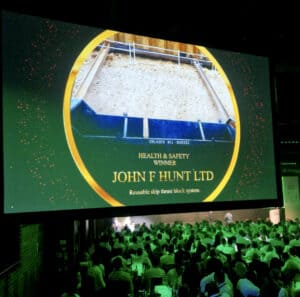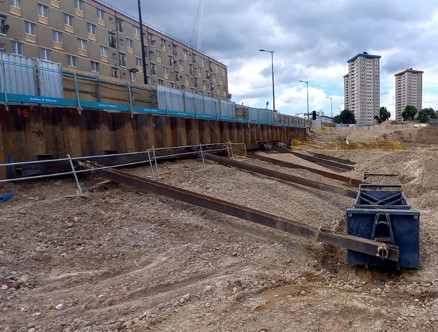

On the 13th of October CONSTRUCT ran its annual awards, recognising excellence, capability, and innovations in concrete construction. John F Hunt Limited were shortlisted twice, attended the event and won the prestigious Health and Safety award!
We were victorious with our innovative reusable skip thrust block introduced at HS2.
John F Hunt and our in-house TW designers developed an innovative solution using 20-yard metal skips (previously brought to site for works in the zone 5 area) repurposed to create non concrete thrust blocks.
A design was developed to strengthen the skips by installing welded cross bracing sections and sealing the door units. Brackets were then installed to the skips and the sheet piles to support an adjustable prop that would brace between the skip thrust block system and the pile wall.
One in position the skips were filled via 360 excavator using 6f2 material that had been retained on site from previous demolition works forming the anchorage that was required for the thrust block to work to the same level of requirement as the previous reinforced concrete design.
This system brought about a number of benefits:
Had the thrust blocks been constructed using reinforced concrete then the ground would have had to been excavated to have accommodate this. This would have resulted in excavations and changes in level that present a risk of falls on site. This was removed by the use of this system.
In addition to the above, operatives would have had to construct timber shutter using hand tools and the manual handling of materials. Again, with the implementation of this skip system this phase of works was removed and as such the risk of HAV, timber dust and manual handling removed along with it.
The use of this system greatly reduced people plant interface throughout the operation as once the skips were in place the works were solely carried out by excavator within an excluded area.
Finally, as the skips are reusable this removed several risks associated with the removal of reinforced concrete element. For example, as there was no concrete thrust block to remove the risk of silica dust was not present removing the requirement for dust extraction, containment and personal RPE.
As the blocks did not require breaking out there was no HAV risk and the risk from noise that such an operation would produce was completely removed (this was of added benefit considering the operations proximity with the site boundary).
There were significant environmental savings gained from developing and employing this system. By not using reinforced concrete to form the thrust block the project immediately saved 30.5 tonnes of CO2e.
There was also additional material and CO2e savings from removing the need for timber shuttering materials involved in casting the blocks. The reduced transport required to employ the skip thrust block method resulted in a further saving of 257.6 kgC02e. The use of the system additionally resulted in programme savings.
Congratulations to the whole team involved in this fantastic win!